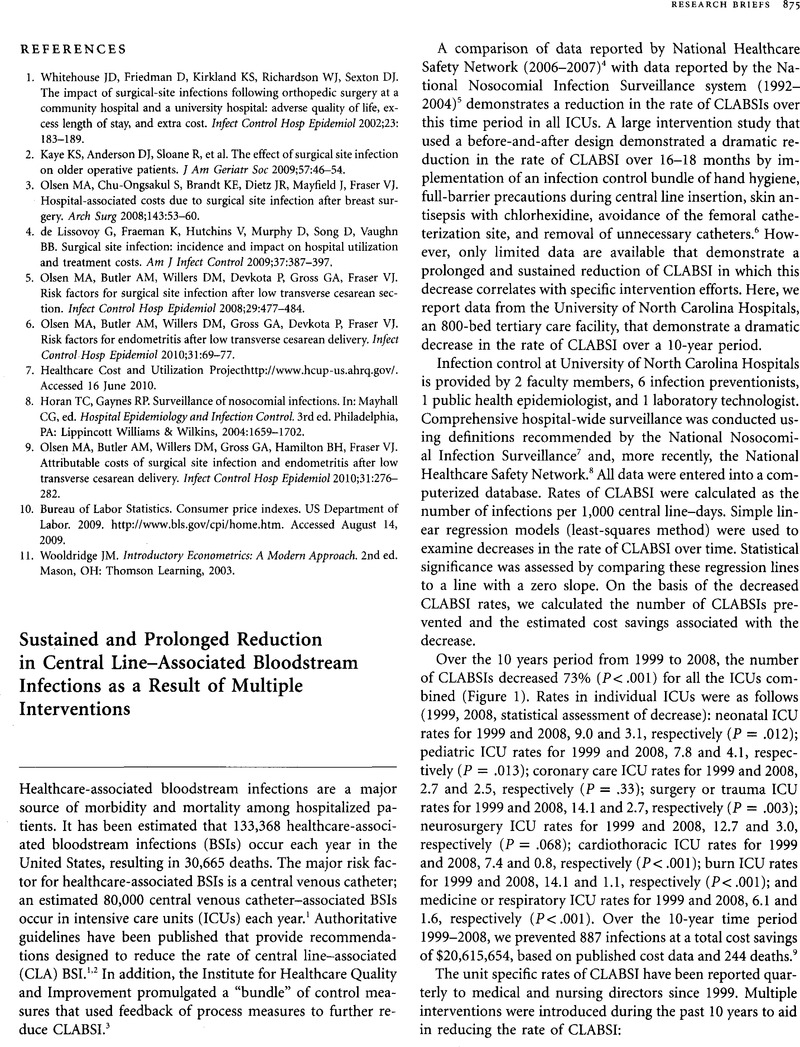Crossref Citations
This article has been cited by the following publications. This list is generated based on data provided by Crossref.
Tatti, Kathleen M.
Sparks, Kansas N.
Boney, Kathryn O.
and
Tondella, Maria Lucia
2011.
Novel Multitarget Real-Time PCR Assay for Rapid Detection of Bordetella Species in Clinical Specimens.
Journal of Clinical Microbiology,
Vol. 49,
Issue. 12,
p.
4059.
Zingg, Walter
Walder, Bernhard
and
Pittet, Didier
2011.
Prevention of catheter-related infection.
Current Opinion in Infectious Diseases,
Vol. 24,
Issue. 4,
p.
377.
Henderson, Donna M.
Staiger, Thomas O.
Peterson, Gene N.
Sinanan, Mika N.
Angiulo, Cindy L.
Makarewicz, Vanessa A.
Wild, Lorie M.
and
Whimbey, Estella E.
2012.
A Collaborative, Systems-Level Approach to Eliminating Healthcare-Associated MRSA, Central-Line–Associated Bloodstream Infections, Ventilator-Associated Pneumonia, and Respiratory Virus Infections.
Journal for Healthcare Quality,
Vol. 34,
Issue. 5,
p.
39.
Paula, Adriana P.
Oliveira, Priscila R.
Miranda, Erique P.
Felix, Cassia S.
Lorigados, Clara B.
Giovani, Arlete M.
and
Lima, Ana Lucia L.
2012.
The long-term impact of a program to prevent central line-associated bloodstream infections in a surgical intensive care unit.
Clinics,
Vol. 67,
Issue. 8,
p.
969.
Kang, JaHyun
Sickbert-Bennett, Emily E.
Brown, Vickie M.
Weber, David J.
and
Rutala, William A.
2012.
Relative frequency of health care-associated pathogens by infection site at a university hospital from 1980 to 2008.
American Journal of Infection Control,
Vol. 40,
Issue. 5,
p.
416.
Miller, Sarah E.
and
Maragakis, Lisa L.
2012.
Central line-associated bloodstream infection prevention.
Current Opinion in Infectious Diseases,
Vol. 25,
Issue. 4,
p.
412.
Fisher, David
Cochran, Keith M.
Provost, Lloyd P.
Patterson, Jacquelyn
Bristol, Tara
Metzguer, Karen
Smith, Brian
Testoni, Daniela
and
McCaffrey, Martin J.
2013.
Reducing Central Line–Associated Bloodstream Infections in North Carolina NICUs.
Pediatrics,
Vol. 132,
Issue. 6,
p.
e1664.
van Duin, David
Jones, Samuel W.
Dibiase, Lauren
Schmits, Grace
Lachiewicz, Anne
Hultman, Charles Scott
Rutala, William A.
Weber, David J.
and
Cairns, Bruce A.
2014.
Reduction in Central Line–Associated Bloodstream Infections in Patients with Burns.
Infection Control & Hospital Epidemiology,
Vol. 35,
Issue. 8,
p.
1066.
DiBiase, Lauren M.
Weber, David J.
Sickbert-Bennett, Emily E.
Denniston, Clark
and
Rutala, William A.
2014.
July Effect: Impact of the Academic Year-End Changeover on the Incidence of Healthcare-Associated Infections.
Infection Control & Hospital Epidemiology,
Vol. 35,
Issue. 3,
p.
321.
Kang, JaHyun
Sickbert-Bennett, Emily E.
Brown, Vickie M.
Weber, David J.
and
Rutala, William A.
2014.
Changes in the incidence of health care–associated pathogens at a university hospital from 2005 to 2011.
American Journal of Infection Control,
Vol. 42,
Issue. 7,
p.
770.
Bonne, Stephanie
Mazuski, John E.
Sona, Carie
Schallom, Marilyn
Boyle, Walter
Buchman, Timothy G.
Bochicchio, Grant V.
Coopersmith, Craig M.
and
Schuerer, Douglas J.E.
2015.
Effectiveness of Minocycline and Rifampin vs Chlorhexidine and Silver Sulfadiazine-Impregnated Central Venous Catheters in Preventing Central Line-Associated Bloodstream Infection in a High-Volume Academic Intensive Care Unit: A Before and after Trial.
Journal of the American College of Surgeons,
Vol. 221,
Issue. 3,
p.
739.
Kanamori, Hajime
Weber, David J.
DiBiase, Lauren M.
Sickbert-Bennett, Emily E.
Brooks, Rebecca
Teal, Lisa
Williams, David
Walters, Elizabeth M.
and
Rutala, William A.
2015.
Longitudinal Trends in All Healthcare-Associated Infections through Comprehensive Hospital-wide Surveillance and Infection Control Measures over the Past 12 Years: Substantial Burden of Healthcare-Associated Infections Outside of Intensive Care Units and “Other” Types of Infection.
Infection Control & Hospital Epidemiology,
Vol. 36,
Issue. 10,
p.
1139.
Wallace, Mary C.
and
Macy, Deborah L.
2016.
Reduction of Central Line-Associated Bloodstream Infection Rates in Patients in the Adult Intensive Care Unit.
Journal of Infusion Nursing,
Vol. 39,
Issue. 1,
p.
47.
Reynolds, Heather
Gowardman, John
and
Woods, Christine
2023.
Care Bundles and Peripheral Arterial Catheters: A Scoping Review.
Journal of the Association for Vascular Access,
Vol. 28,
Issue. 3,
p.
38.
Reynolds, Heather
Gowardman, John
and
Woods, Christine
2024.
Care bundles and peripheral arterial catheters.
British Journal of Nursing,
Vol. 33,
Issue. 2,
p.
S34.



